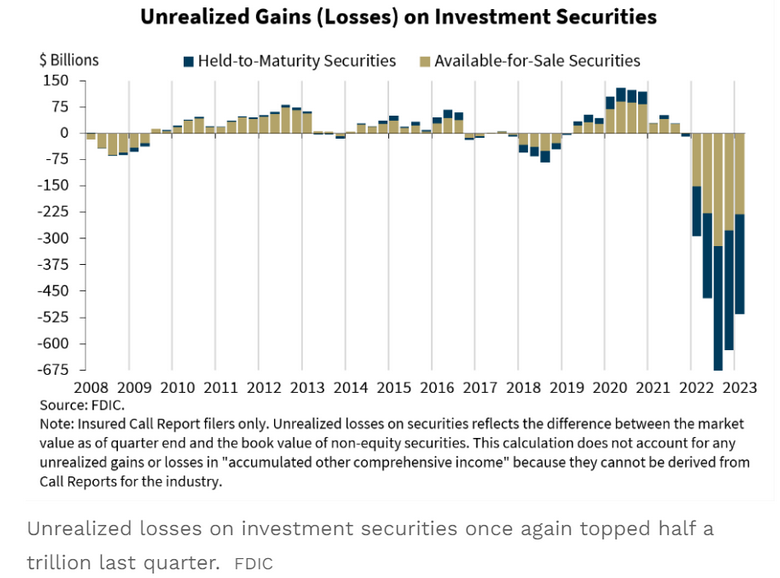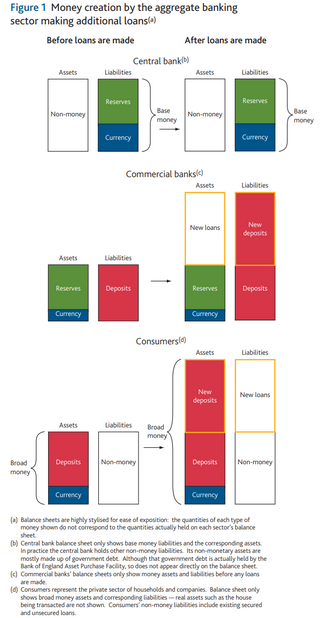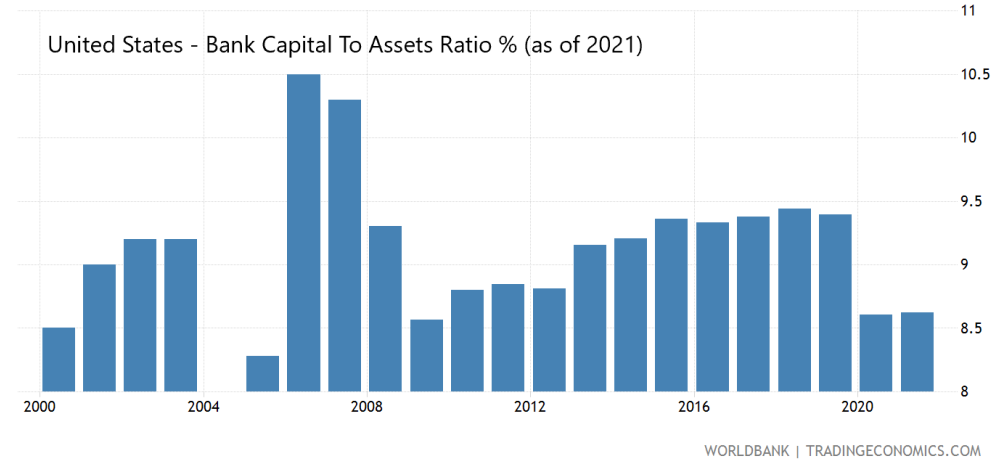Banks have looked increasingly fragile over the last year.
And besides three-of-the-four largest U.S. bank failures happening in early-2023, many feel like the worst is over.
But I disagree.
Because courtesy of the Federal Reserve’s rapid tightening cycle, banks are still sitting on enormous unrealized losses.
To put this into perspective – as of Q1-2023 – banks have over half a trillion in paper losses on their investment books (albeit it’s recovered since late-2022).

Because of this, the Fed had to open the discount window (aka where banks can swap assets for reserves at full value).
If they hadn’t, banks would’ve had to sell these assets at steep losses – most likely causing a wave of further insolvencies (wiping out bank capital).
So, what now?
Well, the banking system is still fragile. And it’s not likely to get better as long as growth keeps fading and short-term rates remain elevated.
There’re three big factors now negatively affecting banks:
1. Banks are tightening lending standards sharply amid growing economic uncertainty and deteriorating fundamentals. Reinforcing the decline in the money supply (which is deflationary).
2. The higher short-term rates have caused deposits to leave banks and rotate into money-market funds (MMFs). Putting pressure on bank stability.
3. Higher short-term rates compared to long-term market rates (aka the inverted yield curve) decrease bank profitability. Squeezing their net-profit margins (NIMs).
I believe the side-effects from banking issues – such as declining loan creation – are what’s really worrying. As it historically leads to instability and deflation.
So, let’s take a closer look into all this and why banks may be stuck for a while. . .
Digging Through Weeds of Banking and Commonly Held Misconceptions
Banking is a wildly complex topic – with many dynamic variables.
But I will try to cover what I can and break it down as simply as possible.
Before we start, there’re many misconceptions about banking – such as:
1. That deposits (liabilities for a bank) fund loans (an asset for a bank).
2. That the central bank ‘prints’ (creates) money into the economy.
3. That banks lend because of interest rates.
These three things are generally false ideas many have been taught in modern banking.
For instance, the central bank doesn’t print anything. It adds reserves with a few keystrokes (which work like a checking account banks use with each other to clear payments).
For example, if Person A at Bank A sends, let’s say, $10,000 to Person B at Bank B. Then Bank A must send the same number of reserves to Bank B.
In theory, if the central bank adds more reserves into the system, it should allow banks to lend more.
But they don’t have to lend.
This is known as a ‘liquidity trap’ (aka when banks and consumers hoard money instead of lending and spending, regardless of monetary easing).
This is what’s happened in Japan post-1991 and the Eurozone post-2011.
Meanwhile, the real money creators are commercial banks.
See – contrary to conventional wisdom – in the modern banking system, bank loans create deposits.
A bank doesn’t check how many deposits it has before making a loan. It simply extends credit. And this becomes buying power for the new borrower.
But remember, a new loan is an asset for the bank (income generating), but it creates an equal liability (the new deposit on which they owe interest or may leave to another bank).
This is important because it means that banks are the true money allocators – choosing where they shovel it out too.
Which is most often in asset-backed areas such as the financial sector, housing, and corporations (as they offer more collateral). Thus fueling asset inflation.
The Bank of England wrote an excellent and in-depth whitepaper on this topic.

But this is the gist. Commercial bank loans create money. And debt repayment destroys money (repaying the loan closes out the liability and equivalent assets).
Thus as banks loan more, it increases the money supply. And when debt repayment increases faster than loan creation, the money supply will shrink (more on this later).
So, what makes banks lend more?
Many were taught that it is interest rates that influence lending. And while it does to an extent, confidence is what really drives credit.
Banks extend credit when they feel confident in repayment, liquidity conditions, and financial system health.
For example – after 2008 – banks stopped lending to each other and extending marginal credit even with interest rates at zero because of uncertainty. Thus rendering the Fed’s easing programs relatively mute for stimulating the economy.
I know this may sound counterintuitive and confusing, but this is how modern banking works.
So, keep these three things in mind for the next parts. . .
2 Types Of Banking Crises: Liquidity vs. Solvency
There are essentially two ways for a bank to fail.
1. A solvency crisis – when bank assets fall, and non-performing loans rise, wiping out bank capital (equity).
Bank capital is derived mostly from shareholder equity (owners), provisions, and retained profits from loans. And it counts as a liability on bank books.
Most banks in the U.S. commonly hold around 8-10% capital-to-asset ratios as a buffer if losses mount.

But a mere 10% fall in asset values or rising debt defaults could wipe out most banks.
This is what happened in 2008. When mortgage loans and various debt defaults rose and sent banks into insolvency.
So, in short, solvency is determined by whether a bank has sufficient capital to cover losses on assets (loans).
2. A liquidity crisis – when a bank lacks sufficient assets to meet liabilities (aka if they can sufficiently meet sudden withdrawals).
This is often referred to as the ‘asset-liability maturity mismatch’.
Banks typically lend long into illiquid assets (such as a 30-year mortgage) while at the same time holding short-term liabilities (such as customer deposits).
Now, if confidence in the bank declines and customers want their deposits out, this mismatch becomes a problem.
Because the bank must sell assets to meet the liability outflows.
The problem is – if confidence is shaky, the assets may go at steep discounts (aka below their book values). Which leads to a ‘fire sale’.
This is essentially what we saw happen in 2023 with Silicon Valley Bank ($SVB) in March (I wrote more about this soon after).
Their asset prices were down, and they couldn’t meet the outflow of deposits.
For instance, SVB tried to sell $21 billion in high-quality mortgage-backed and Treasury assets but had to offload them at a roughly 10% discount. Which amplified the lack of confidence in their loan books.
This is why the Fed opened the discount window and emergency lending programs for other banks so that they could sell assets at full prices. Because banks were all sitting on the same massive unrealized losses.
So, in short, a liquidity crisis is determined by whether a bank has sufficient liquid assets to meet liabilities.
Now, you may be thinking, “But if banks can create loans (assets), how can they go bust?”
Good question. But here’s the issue.
Creating money through loans (assets) also increases deposits (liabilities) in equal amounts. So it does not affect the net difference between the two.
For a bank to become solvent again, it must find ways to reduce its liability outflows or increase its asset values (which isn’t easy to do once confidence is shaken).
Meanwhile – during a liquidity crisis – creating more loans and deposits could make the situation worse as those new deposits can be yanked out and put into another bank. Amplifying the imbalance.
Also, if a bank is technically insolvent, it can’t really extend new credit.
Thus it’s important to keep these two concepts in mind when studying banks and fundamentals.
This brings us to the next part.
Banking System Is on Shaky Grounds
After the Q1-2023 banking stress, commercial banks have started to cut back on credit creation.
And whether it’s from Fed tightening, deposit outflows into money markets, or fading confidence in the economy – this has big implications for liquidity and banks.
To put this into perspective – according to The Motley Fool – commercial bank credit has declined 1.61% since its March 15, 2023 peak level.

This is the largest drop since 2008-09.
And while this may seem harmless. It’s significant since – as I mentioned above – banks are the money creators.
The Motley Fool further notes that
“During the three previous instances [1975, 2002, 2008-2010) where commercial bank credit broke from its seemingly endless uptrend and fell by at least 1.5%. The S&P 500 lost in the neighborhood of 50% of its value.”
Banks are still sitting on massive unrealized losses and dealing with an inverted yield curve. Thus it makes sense they’re curtailing credit.
But this becomes a self-amplifying feedback loop.
Because less credit means less asset price and economic growth. Which leads to further loan losses and instability. And on and on.
Making matters worse, the U.S. broad money supply (aka M2) plunged negative 5% in year-over-year terms. It’s the first and largest net decline since data collected post-1960s.

Meanwhile, U.S. liquid money supply (aka M1) is down 10% year-over-year. By far the largest decline since 1960.
This means that U.S. money supply flows are declining.
And as banks tighten credit further (fewer loans) relative to debt repayments – further money destruction will occur. Which is deflationary.
Now – as I’ve written about before – deflation may sound like a good thing (and it can be).
But in a monetary system hooked on debt, this has serious downsides.
Because if asset prices fall while nominal debt burdens stay the same, it actually increases the cost of debt. And it also squeezes corporate profit margins and weakens growth.
In fact, I believe this is a big reason why the Fed paused its rate tightening cycle in June.
And although they say they expect two more hikes by year-end, I remain skeptical.
It will only amplify the banking stress and the ripple effects that come from it.
Many modern economists and central bankers discount the role of the financial and banking system in the macro-world. Believing they’re simply intermediaries (aka neutral to the economy).
But this is absurd.
Classical economists like Irving Fischer, John Maynard Keynes, F.A. Hayek, and Hyman Minsky all warned that the operation of the financial system carried vital implications for macro-stability.
Creating vicious feedback loops (booms as credit extends and busts when credit contracts).
Banks are the outlets and allocators of credit into the economy. Playing a key role in asset prices and growth.
And as banks look to deal with their own issues – especially with the massive unrealized losses – expect credit growth to further contract and volatility to proliferate with it. Amplifying the current fragility.
Beware.
PS – I’m aware there’s much more to banking than I went over. I just wanted to touch on some of the modern banking basics and their potential issues going forward.
